


|

|
|
|
|
Installing WebLogic Commerce Server
This chapter includes the following sections:
Note: Please see the Release Notes for information about applying the latest Service Pack of WebLogic Commerce Server and WebLogic Personalization Server 3.1.1.
In this chapter, the environment variable WL_COMMERCE_HOME is used to indicate the directory in which you installed the WebLogic Commerce Server 3.1.1 and WebLogic Personalization Server 3.1.1 software.
Before You Begin
Before you start the installation procedure, read the product Release Notes and all of Preparing to Install. Also refer to the following checklist:
For more information about the required Java 2 SDK versions and WebLogic Server service pack version for your platform, see the Supported Platforms section of the Release Notes at http://download.oracle.com/docs/cd/E13210_01/wlcs/docs31/relnotes/relnotes.htm#platforms.
Installing the Software on Windows Systems
This section explains how to install the WebLogic Commerce Server software on a Windows system. For more information about the supported Windows platform(s), see the Supported Platforms section of the Release Notes at http://download.oracle.com/docs/cd/E13210_01/wlcs/docs31/relnotes/relnotes.htm#platforms. The installation shown in this section is on a Windows NT 4.0 SP5 system.
Warning: If you are re-installing the WebLogic Commerce Server 3.1.1 software on the target system, make sure you first create backup copies of any files that you customized, such as the weblogiccommerce.properties file and weblogic.properties file in the %WL_COMMERCE_HOME% directory.
Figure 2-1 Initial InstallAnywhere Screen
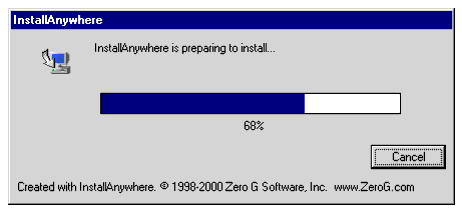
Figure 2-2 Software Installation Splash Screen

Select a language for the InstallAnywhere text and click the OK button.
Figure 2-3 Introduction Screen
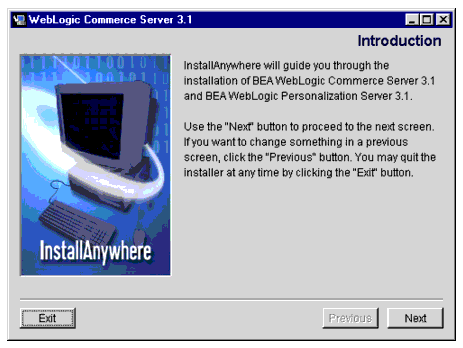
Click the Next button.
Figure 2-4 License Agreement Screen
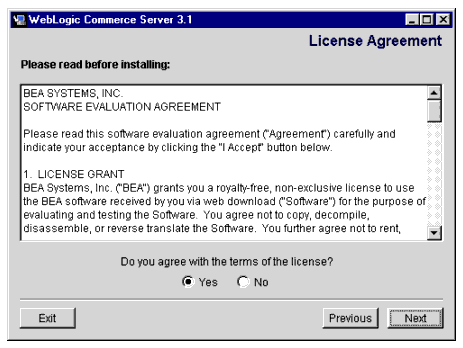
Please read the entire license agreement. If you agree, click the Yes radio button and then click the Next button.
Figure 2-5 Important Information Screen
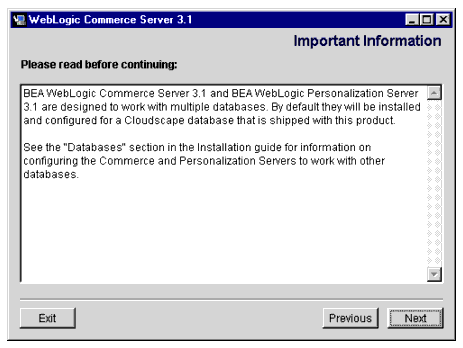
For information about changing the database type from Cloudscape to Oracle, see Database Configuration. To proceed with the installation, click the Next button.
Figure 2-6 Choose Install Folder Screen

Note: The WebLogic Commerce Server 3.1.1 software installation will not affect data from previous versions of the products. However, you must install the 3.1.1 software in a new directory. Do not install the 3.1.1 software in a directory that contains prior versions of WebLogic Commerce Server, WebLogic Personalization Server, WebLogic Portal, WebLogic Application Solutions, or BEA JumpStart.
WebLogic Commerce Server 3.1.1 needs about 200 MB of disk space to perform the software installation. When the installation completes, the installed files comprise less than 130 MB. This count is an estimate and might be different on your system. The count does not include the size of the product's documentation files. For more information about installing documentation, see Using the Separate Documentation ZIP Kit.
After you select the target installation folder, click the Next button.
Figure 2-7 Choose JDK Directory Screen

Specify the location of the JDK directory; then click the Install button to continue the WebLogic Commerce Server installation.
Figure 2-8 Choose WebLogic Directory Screen

Figure 2-9 Install Complete Screen
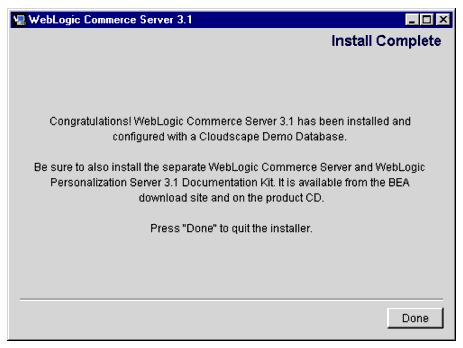
Notice the message about installing the separate documentation kit after you complete the software installation. Click the Done button to complete the software installation. See the section Using the Separate Documentation ZIP Kit for information about installing the documentation files.
Do Not Forget the License File
After the software installation completes and before you start the server, copy the WebLogicCommerceLicense.xml license file you downloaded or purchased to the %WL_COMMERCE_HOME%\license directory.
Using WLCS_311.bin to Install on a UNIX System That Has a windowing Environment
This section explains how to install the WLCS and WLPS 3.1.1 software on a supported UNIX system that has a windowing environment. This section shows the installation using the WLCS_311.bin kit.
For installations on UNIX systems that do not have a windowing environment, see the section Using WLCS_311.zip to Install on a UNIX System That Does Not Have a windowing Environment.
For more information about the supported UNIX platform(s), see the Supported Platforms section of the Release Notes at http://download.oracle.com/docs/cd/E13210_01/wlcs/docs31/relnotes/relnotes.htm#platforms. The installation shown in this section is on a Sun Solaris 7 system.
Before you start the installation, note that the installation requires a Java Virtual Machine (JVM) in your path. That is, the <JDKHome>/bin directory must be in the path. This requirement should not be confused with the JDK Home that is specified during the installation. On the Choose JDK screen of the installer, be sure to enter the JDK Home directory without the /bin directory on the end.
Warning: If you are re-installing the WebLogic Commerce Server 3.1.1 software on the target UNIX system, make sure you first create backup copies of any files that you customized, such as the weblogiccommerce.properties file and weblogic.properties file in the 3.1.1 $WL_COMMERCE_HOME directory.
The WLCS_311.bin installation procedure uses InstallAnywhere and requires a windowing environment. For installations on UNIX systems, invoke the WebLogic Commerce Server 3.1.1 installation program on a machine that is running a windowing environment. Or run the WebLogic Commerce Server 3.1.1 installation program on a system that has a windowing environment, and specify a target installation directory on a UNIX workstation that may or may not have the windowing environment.
$ sh WLCS_311.bin
The installation program finds the Java Virtual Machines (JVMs) that are available to your workstation and prompts you to choose one. (See Figure 2-10.)
Figure 2-10 Select a JVM
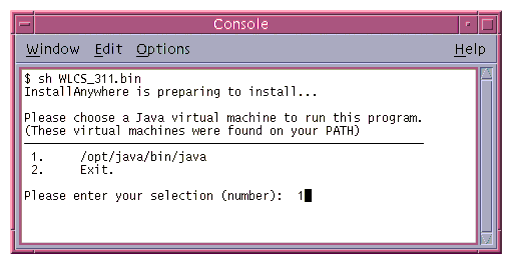
Select a language for the InstallAnywhere text and click the OK button.
Figure 2-11 Introduction Screen on UNIX
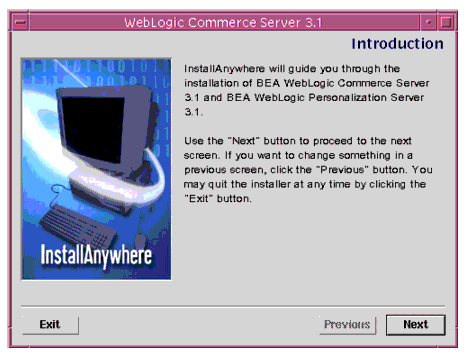
Click the Next button.
Figure 2-12 License Agreement Screen on UNIX
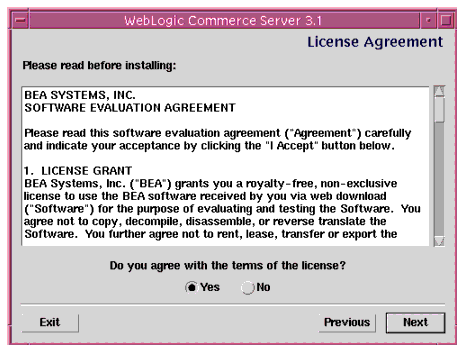
Please read the entire license agreement. If you agree, click the Yes radio button and then click the Next button.
Figure 2-13 Important Information Screen on UNIX

For information about changing the database type from Cloudscape to Oracle, see Database Configuration. To proceed with the installation, click the Next button.
Figure 2-14 Choose Install Folder Screen on UNIX
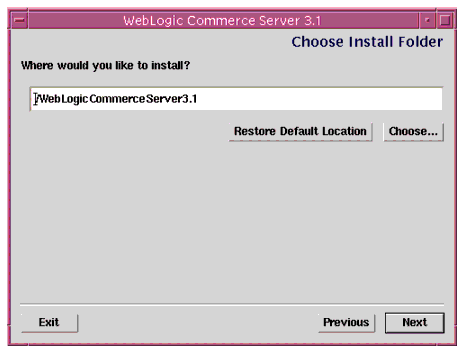
Note: The WebLogic Commerce Server 3.1.1 software installation will not affect data from previous versions of the products. However, you must install the 3.1.1 software in a new directory. Do not install the 3.1.1 software in a directory that contains prior versions of WebLogic Commerce Server, WebLogic Personalization Server, WebLogic Portal, WebLogic Application Solutions, or BEA JumpStart.
WebLogic Commerce Server 3.1.1 needs about 200 MB of disk space to perform the software installation. When the installation completes, the installed files comprise less than 130 MB. This count is an estimate and might be different on your system.
The count does not include the size of the product's documentation files, which can be installed after the software installation completes. The documentation files comprise an additional 60 MB of disk space (including all the Javadoc) and are packaged in a separate installation kit, WLCS_311_DOC.zip. For more information, see the section Using the Separate Documentation ZIP Kit.
After you select the target installation folder, click the Next button.
Figure 2-15 Choose WebLogic Directory Screen on UNIX
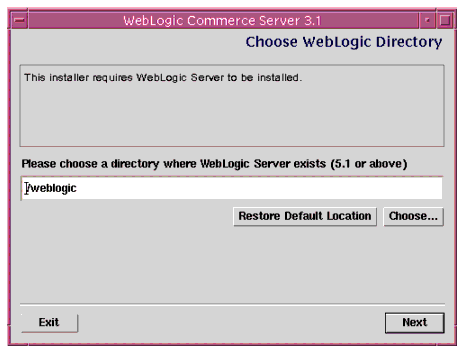
After you identify the location of the WebLogic Server 5.1 installation directory, click the Next button.
Figure 2-16 Choose JDK Directory Screen on UNIX

After you identify the location of the Java 2 SDK on the target system, click the Next button.
Do Not Forget the License File
After the software installation completes and before you start the server, copy the WebLogicCommerceLicense.xml license file you downloaded or purchased to the $WL_COMMERCE_HOME/license directory.
Using WLCS_311.zip to Install on a UNIX System That Does Not Have a windowing Environment
This section explains how to use the WLCS_311.zip kit to install the WLCS and WLPS 3.1.1 software on a UNIX system that does not have a windowing environment.
For installations on UNIX systems that do have a windowing environment, see the section Using WLCS_311.bin to Install on a UNIX System That Has a windowing Environment.
For more information about the supported UNIX platform(s), see the Supported Platforms section of the Release Notes at http://download.oracle.com/docs/cd/E13210_01/wlcs/docs31/relnotes/relnotes.htm#platforms. The installation shown in this section is on a Sun Solaris 7 system.
Note: If you are re-installing the WebLogic Commerce Server 3.1.1 software on the target UNIX system, make sure you first create backup copies of any files that you customized, such as the weblogiccommerce.properties file and weblogic.properties file in the WLCS 3.1.1 $WL_COMMERCE_HOME directory.
For example:
$ mkdir /apps/bea/wlcs
$ cd /apps/bea/wlcs
$ jar xvf /kits/bea/wlcs/WLCS_311.zip
$ pwd
apps/bea/wlcs
$ cd WebLogicCommerceServer3.1
$ pwd
/apps/bea/wlcs/WebLogicCommerceServer3.1
$ chmod 755 install.sh
$ ./install.sh
Please enter the directory where JDK is installed (Version 1.2.x is supported):
/export/jdk/jdk1.2.1-04
Please enter the directory where WebLogic is installed (Version 5.1.0 is supported):
/opt/weblogic
Finding Configuration files...
#### Configuring ./bin/unix/cloudscape.sh.stock...
#### Configuring ./bin/unix/license-info.sh.stock...
#### Configuring ./bin/unix/loaddata.sh.stock...
#### Configuring ./bin/unix/loaddocs.sh.stock...
#### Configuring ./bin/unix/LoaderDriverProperties.xml.stock...
#### Configuring ./bin/unix/loadrules.sh.stock...
#### Configuring ./bin/unix/set-environment.sh.stock...
#### Configuring ./db/cloudscape/create-all-cloudscape.sh.stock...
#### Configuring ./db/cloudscape/create-wlcs-cloudscape.sh.stock...
#### Configuring ./db/cloudscape/create-wlps-cloudscape.sh.stock...
#### Configuring ./dbloader.properties.stock...
#### Configuring ./StartCommerce.sh.stock...
#### Configuring ./weblogic.properties.install...
#### Configuring ./weblogiccommerce.properties.install...
$ pwd
/apps/bea/wlcs/WebLogicCommerceServer3.1
$ ls
bin license
classes pipeline.properties
db rulesheets
dbloader.properties server
deploy src
dmsBase StartCommerce.sh
eval webflow.properties
install.sh weblogic.properties
lib weblogiccommerce.properties
$ pwd
/apps/bea/wlcs/WebLogicCommerceServer3.1
$ cp /<directory-containing-license-file>/WebLogicCommerceLicense.xml license
(It is not a problem if the documentation uninstaller file does not exist.)
Example commands to set execute permissions on the specified files:
$ pwd
/apps/bea/wlcs
$ cd WebLogicCommerceServer3.1
$ pwd
/apps/bea/wlcs/WebLogicCommerceServer3.1
$ find . -name "*.sh" -exec chmod 755 {} \;$ find . -name "*.so" -exec chmod 755 {} \;$ chmod 755 ./UninstallerData/Uninstaller_Commerce_Server
$ chmod 755 ./UninstallerDataDocs/Uninstall_WLCS_DOC
$ find . -name "*.sh" -ls
$ find . -name "*.so" -ls
$ ls -l ./UninstallerData/Uninstaller_Commerce_Server
$ ls -l ./UninstallerDataDocs/Uninstall_WLCS_DOC
(It is not a problem if the documentation uninstaller file does not exist.)
Using the Separate Documentation ZIP Kit
This section explains how to use the separate documentation kit, WLCS_311_DOC.zip. The ZIP file is on the BEA Download site, on the last download page for WebLogic Commerce Server 3.1.1.
The unzipped documentation files require about 60 MB of disk space, including all the Javadoc.
When you unzip the files in WLCS_311_DOC.zip, the WebLogic Commerce Server and BEA WebLogic Personalization Server 3.1.1 software does not necessarily have to be installed already on the target system.
Important: To retain the hierarchy of the documentation directories, remember to enable the "Use Folder Names" option (or equivalent) in the program that you use to unzip the files.
You have two options with the WLCS_311_DOC.zip file:
You can unzip the documentation files into a directory of your choice on your system. If you (optionally) have the product software installed on the target system, online Help calls from the product's Administration screens will not find the local copy of the documentation files. Instead, the Administration Help calls will attempt to find the documentation files on the BEA "e-docs" Web site.
You can unzip the documentation files into a specific subdirectory of an existing, installed WLCS 3.1.1 directory. If the documentation files are unzipped into the correct subdirectory, this manual option (along with an important, post-unzip-operation step), will enable Administration screen Help calls to find the local copy of the documentation files. This option requires a few manual steps by the person who is performing the unzip operation.
Standalone Documentation Kit Instructions
Please follow these steps to use the documentation kit as a standalone set of files that do not require an existing WLCS 3.1.1 software installation.
$ mkdir myWLCS311docs
Manually Integrated Documentation Kit Instructions
Please follow these steps to manually integrate the documentation files into an existing WLCS 3.1.1 directory structure.
/weblogiccommerceserver3.1/server/public_html
$ mkdir docs
WL_COMMERCE_HOME/classes/com/beasys/commerce/util
Note: The property values in DocumentMapping.properties, along with a DocumentMappingSI.properties file, are used to map calls from the product's administration screens to the documentation files. The software kit provides the DocumentMappingSI.properties file. If the WLCS code finds the DocumentMapping.properties file, the local documentation files in server/public_html/docs/... are used when you click a Help icon on an Administration screen. Otherwise, the DocumentMappingSI.properties file is used to find the corresponding documentation files on the BEA e-docs Web site.
Verifying Software Installation
Follow these steps to verify that the software was properly installed.
On Windows systems, another way to start the server is to use the Start menu. For example:
Start-->Programs-->WebLogic Commerce Server 3.1-->Start Commerce Server
WebLogic Commerce Server opens a console window.
By default, WebLogic Commerce Server is configured to use a Cloudscape database that is already built and loaded with sample data. If you configure the server to use an Oracle database or recreate a database, the console output includes a prompt for creating credit card encryption/decryption keys. For information about this prompt, see The Credit Card Encryption/Decryption Prompt. For information about using Oracle and Cloudscape databases, see Database Configuration.
When the server completes its startup process, it displays the following message in the console output:
date stamp:<I> <WebLogicServer> WebLogic Server started
For example:
Fri Oct 13 11:32:01 EDT 2000:<I> <WebLogicServer> WebLogic Server started
Note: Refer to Additional Configuration Steps for information about making configuration changes to the system. You need to change configurations if you use a database other than Cloudscape or a Document Management System (DMS) other than the reference implementation DMS shipped with WLCS 3.1.1. The configuration chapter also contains information about configuring other pieces of the system.
Note: Each page loads slowly the first time you access it because the Java compiler has to compile the page source code. Subsequent loads and refreshes of the page go much faster than the initial load.
# Defines the example portal WAR deployment.
weblogic.httpd.webApp.portal=D:/WebLogicCommerceServer3.1/server/webapps/examples/portal/portal.war
# Defines the wlcs Web Application.
weblogic.httpd.webApp.wlcs=D:/WebLogicCommerceServer3.1/server/webapps/wlcs/
With the server running, the format of the URLs on the local machine are as follows:
http://localhost:7501/portal
http://localhost:7501/wlcs
Uninstalling the Software
This section explains how to uninstall (remove) the WebLogic Commerce Server 3.1.1 and WebLogic Personalization Server 3.1.1 software that was installed previously with the WLCS_311.exe or WLCS_311.bin procedures.
Note: This section does not apply if you used the WLCS_311.zip install script, which is for supported UNIX systems that do not have a windowing environment.
Uninstalling the Software on Windows Systems
The steps to uninstall (remove) the WebLogic Commerce Server and WebLogic Personalization Server software on Windows systems are as follows:
Start-->Programs-->WebLogic Commerce Server 3.1-->Uninstall Commerce Server
Figure 2-17 First Uninstall Screen
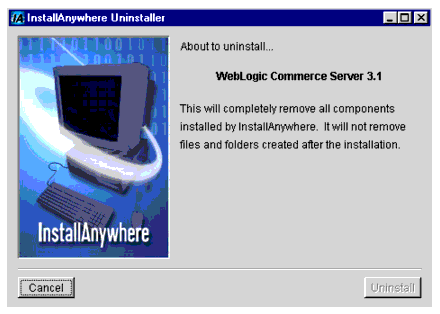
Click the Uninstall button to start the removal of WebLogic Commerce Server and WebLogic Personalization Server files from your system. (InstallAnywhere usually has a delay enabling the display of its Uninstall button as it gathers information.)
Figure 2-18 Progress Screen During the Uninstall

Figure 2-19 Sample Uninstall Results Screen
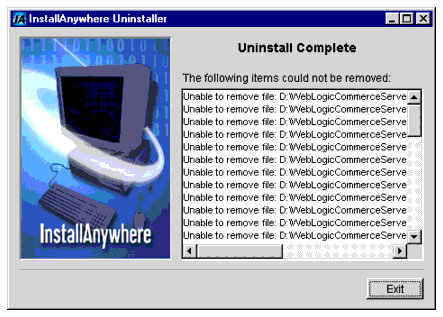
Click the Exit button.
After the uninstall, check any remaining files in the WL_COMMERCE_HOME directory structure and decide whether you need to set those files aside for subsequent use.
Uninstalling the Software on UNIX Systems
The steps to uninstall the WebLogic Commerce Server software on UNIX systems is similar to the steps on Windows systems.
Note: This section does not apply if you used the WLCS_311.zip install script, which is for supported UNIX systems that do not have a windowing environment.
You start by going to the UninstallerData directory, and then run the script Uninstall_Commerce_Server. For example:
Figure 2-20 Sample Console


|

|

|
|
|
|
Copyright © 2000 BEA Systems, Inc. All rights reserved.
|